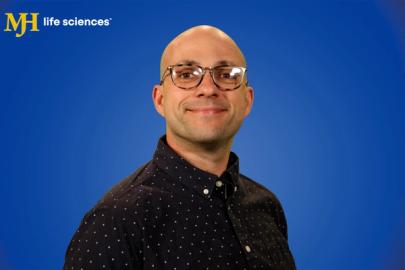- About Us
- Advertise / Support
- Editorial Board
- Contact Us
- CancerNetwork.com
- TargetedOnc.com
- OncLive.com
- OncNursingNews.com
- Terms & Conditions
- Privacy
- Do Not Sell My Information
- Washington My Health My Data
© 2025 MJH Life Sciences™ and CURE - Oncology & Cancer News for Patients & Caregivers. All rights reserved.
Inside the ‘Weird and Wacky’ Frontier of New Targeted Therapy for Lung Cancer

A nationally-published, award-winning journalist, Alex Biese joined the CURE team as an assistant managing editor in April 2023. Prior to that, Alex's work was published in outlets including the Chicago Sun-Times, MTV.com, USA TODAY and the Press of Atlantic City. Alex is a member of NLGJA: The Association of LGBTQ+ Journalists, and also performs at the Jersey Shore with the acoustic jam band Somewhat Relative.
Dr. Benjamin Herzberg spotlighted some of the “weird and wacky” new ideas in the field of targeted therapies for the treatment of lung cancer.
At the recent CURE Educated Patient® Lung Cancer Summit, held in tandem with the 2025 PER® New York Lung Cancer Symposium, Dr. Benjamin Herzberg spotlighted what he described as the “weird and wacky” new ideas in targeted therapy for the treatment of lung cancer.
Herzberg is an assistant professor of medicine at the Columbia University Irving Medical Center in New York City.
“I like weird and wacky, because new ideas are where we get the most mileage from. I like to champion these newer, more offbeat chances of getting new therapies to patients.”
Herzberg explained to attendees that, despite rapid expansion in targeted therapies for lung cancer during the last 25 years, approximately 25% to 30% of patients with lung cancer were not represented in a pie chart he presented, in reference to common major genetic targets, such as EGFR and KRAS mutations.
“The pie chart almost adds up to 100%. It does not quite add up to 100% of all cancer patients, but it is getting there,” he said. “The problem is approximately 25% to 30% of patients do not have a mutation that falls on that pie chart, and the chart is becoming exhausted as a place to find new treatments.”
Genetic anomalies not represented on the chart, Herzberg noted, include MTAP deletions, SMARC4 mutations and p53 mutations.
“You can have an overlap,” Herzberg said, “so, you can have an EGFR mutation or a KRAS mutation and also have one of these mutations, which might give you two bites of the apple of designing a strategy to kill the cancer.
“The other reason I think it’s interesting is early trials in all three of these have shown some success. The hope is that you would now get multiple targeted therapies coming together to be a precision strategy to treat exactly an individual patient's type of tumor.”
These targets, Herzberg said, have required new chemistry and new ideas from scientists working to determine how to develop drugs against them.
For example, Herzberg noted that p53 is likely the oldest known mutation in all of cancer. “p53’s job in your cell is to tell your cells when to die, when they shouldn't be growing,” Herzberg said. “And so, you can imagine why cancers want to get rid of that signal from p53, because they want to keep not dying, that's like their job as cancer cells. p53 is inactivated in a lot of cancers.
“For the first time in the last year, we have seen medicines that reactivate p53, which looks most exciting. Forty-five percent of patients had tumor shrinkage by simply giving a medicine that reactivates p53. There are many p53 mutations in lung cancer. These treatments are not for all p53 mutations; they are only for a few right now because this is difficult, and scientists have had to approach it mutation by mutation. But this is promising for the future, and we might have more customized strategies like this.”
What the Targeted Therapy Landscape Looks Like in Lung Cancer Today
Herzberg concluded by stating that “targeted therapy is really good when you can give it. It generally provides stronger cancer shrinkage, fewer side effects and often long-term cancer control. In cases such as ALK mutations, we now see patients living five, six or seven years before experiencing any worsening of their cancer. It is amazing. None of us thought that would ever be true.”
Targeted therapies, he added, also carry downsides.
“Each targeted therapy, unlike some of our immunotherapies, is somewhat unique, and developing them for small patient groups can be harder,” he said. “The other downside is that they almost never work forever. A very small percentage of the time do they eliminate the cancer completely. However, the future is exciting. There is more and more cool and important work emerging, and huge advances in chemistry are powering many of these developments.”
References
- “Novel Targets (KRAS G12C, HER2, MET exon 14 skipping, RET fusions),” by Dr. Benjamin Herzberg. CURE Educated Patient® Lung Cancer Summit; Nov. 15, 2025; New York, New York.
For more news on cancer updates, research and education, don’t forget to subscribe to CURE®’s newsletters here.
Related Content:



